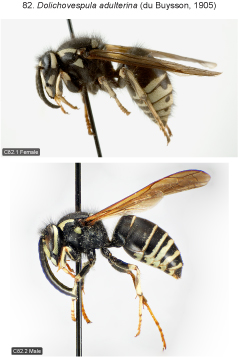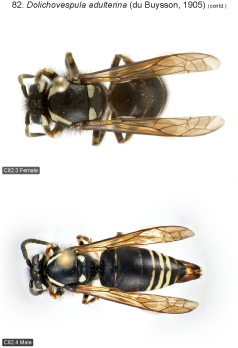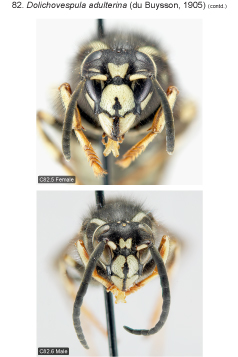
| Home | Table of contents | Keys | Species list | Glossary | Image data | PDF | Cite this article | Feedback | Updates |
Identification Atlas of the Vespidae (Hymenoptera, Aculeata) of the northeastern Nearctic region
CJAI 05, February 19, 2008
doi: 10.3752/cjai.2008.05
Matthias Buck, Stephen A. Marshall, and David K.B. Cheung
Department of Environmental Biology, University of Guelph, Guelph, Ontario, Canada N1G 2W1
Next species | Previous species | Key
82. Dolichovespula adulterina (du Buysson, 1905)
Figs B12.2, 8, 16–18; C82.1–10.
 |
 |
 |

Species recognition. Other ivory-marked Dolichovespula species differ from D. adulterina in that either the hind tibia is black or almost completely black (D. maculata) or the apical fasciae of terga 1–5 are neither interrupted nor narrowed (D. norwegica, worker, queen) or terga 1 and 2 possess ferruginous markings (D. norwegica, male, worker).
Variation. Fore wing length 13.0–14.0 mm (♀♀), 10.0–12.0 mm (♂♂). Pale markings of body ivory, rarely pale yellow. The yellow colour form occurs mostly in the western Nearctic and in the Palaearctic portion of its range (specimens from the latter can be marked with pure yellow). Bequaert (1932) and Miller (1961) mention yellow-marked specimens only from the western Nearctic but very rarely they also occur in the east (1 ♂, PA, Scranton, AMNH; J.M. Carpenter, pers. comm.). Clypeus with usually elongate, rarely small and round, black discal spot, in female almost always, in male often extending to ventral margin of clypeus, in melanic specimens sometimes extending to dorsal margin as well. Ivory postocular band interrupted or narrowed near middle, in male often hardly narrowed at all. Ivory posterior band of pronotum usually more or less broadened at pronotal carina (on average more pronounced in female); pronotum laterally behind pronotal fovea sometimes with small ivory spot (rarely present in female). Metanotum sometimes lacking pair of ivory spots (more often in male than in female). Apical fascia of tergum 1 and in male also of tergum 2 often strongly reduced, rarely completely absent. Female with pairs of black discal spots almost always present at least on tergum 5, at most on terga 3–5; one xanthic female with a pair of enclosed ivory spots in black band of tergum 2. Apical fasciae interrupted at least on terga 1 and 2, interrupted or medially incised on following terga. Male tergum 6 usually with less developed fascia than previous terga, in some cases entirely black; male tergum 7 usually black, rarely with a pair of ivory spots.
Distribution. Canada: all provinces and territories except NU. Northern and western U.S.: AK, south to GA, KY, IL, WI, MN, ND, NM, AZ and CA. Palaearctic (and adjacent parts of Oriental) from northern and western Europe to Sakhalin, Japan, northern China and Taiwan, south to Turkey, Georgia and Mongolia (Carpenter and Kojima 1997, Archer 1999).
Biology. This is the only obligate social parasite (lacking worker caste) of the genus Dolichovespula in North America. Nearctic hosts are D. arenaria and the western D. alpicola (as D. saxonica (Fabricius) in Wagner, 1978, misidentification; incorrectly cited as D. norvegicoides in Akre et al. 1981); in the Palaearctic D. saxonica and D. norwegica are the only confirmed hosts (Carpenter and Perera 2006, Dvořák 2007). The parasite queen invades the host nest early in the season before workers have emerged. The foundress is ultimately killed but later in the season males of the host species may still be produced by host workers laying unfertilized eggs (Akre et al. 1981).
Next species | Previous species | Key
| Home | Table of contents | Keys | Species list | Glossary | Image data | PDF | Cite this article | Feedback | Updates |
